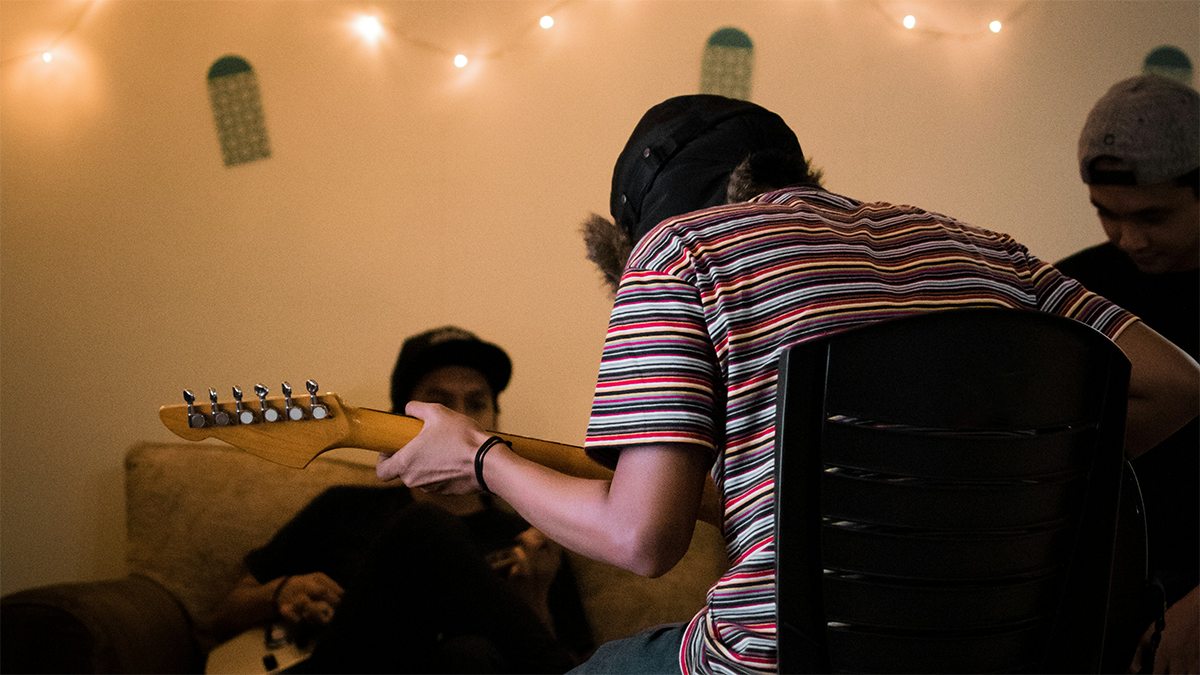“We should jam sometime.” What does that mean? How do I play music with other people? What makes for a good jam session? Let’s check it out.
Call me biased, but making music is the best hobby. Musical practices date back farther than history can tell us. It’s in our bones. That’s why it’s so much more magical when we do it with others — it awakens something primal deep within us. Or maybe its just a good excuse to get together with friends and let loose. Either way, you’ve got a song in your heart yearning to be free. You may already play an instrument or sing along to your favorite artist, but you want something more. You want to feel the lightning at your fingertips as God Herself speaks through you. But let’s not get ahead of ourselves. You wouldn’t be here if you didn’t need a little help.
Let’s learn about the almighty jam session.
“We Should Have a Jam Session Sometime!”
What is “jamming“? Jamming gets its roots from the jazz movement of the 1920s, when professional jazz musicians would get together in private to play without restrictions, able to be free and more experimental than they could be at paying gigs. Jamming today can refer to a variety of different ways that musicians get together and create music, and for many different reasons. For new musicians, it’s a way to apply what you’ve practiced and gain experience playing with others. For hobby musicians, it’s a great way to hang out with friends and blow off steam. Jam sessions can also be a useful tool for professional musicians to create and develop ideas for new music.
Step One
Okay so, maybe this is step two or three if you want to count learning an instrument and having the desire to jam with others. Regardless, you’re bored of sitting in your room playing by yourself. You want to experience what it’s like to play with others. So first:
Find a Reason
Like I listed before, there are many different reasons that you may want to get into jam sessions. Are you looking to just have fun, or do you want to grow as a musician? It is purely for leisure or are you hoping to start a new project and perform? Asking yourself these questions is important when it come to the next step:
Find People
Okay, this is obvious. You can’t have a jam session with only one person. But where should you look? You’d be surprised to find that there are musicians all around you. If you aren’t already friends with a musician or two, ask around. Don’t be afraid to get out of your comfort zone. Talk to people at work or school and let them know you’re looking for other musicians to jam with. Go to local shows at a dive bar and talk to people in the crowd. There’s a great chance that other musicians are there enjoying and studying the craft of the performers. Once you’ve found some people:
Find a Space
This is a tough one. Not everybody has a big cabin in the woods far away from pesky neighbors. Noise is a big factor for where and when you can play (especially if a drumkit is involved). Ideally, you or one of your jam buddies has a basement or garage that can be utilized.
The Jam Session
There are a few different methods to achieve this, and they’re not all created equal. Sure, you can get together with no solid plan of what to do, but you’re leaving yourself open to an awkward and unfruitful experience. Here’s what I suggest to get the most out of your jam session:
Keep it simple: There’s no need to reinvent the wheel. You and your jam buddies most likely have some tastes in common. Maybe there’s a song that you all know how to play or can learn quickly. Covering songs can be very helpful especially when jamming with people for the first time. You don’t have to decide what to play or how it’s going to go, and it gives you the chance to experience the quirks and nuances of the people you’re playing with. Studying other artist’s songs also give you the roadmap for how to write some of your own. Try using a progression from a song you like and jamming on top of that. You can change the tempo, rhythm, or instrumentation to fit your own style.
Keep it predictable: Once you’ve decided what you’re going to play, and made sure you’ll all be playing complementary notes at the same time, stay on the path. The best way to complement one another’s playing is by knowing what’s going to come next. A key aspect of pleasing music is repetition. A singer can’t improvise a melody on top of a progression if that progression changes suddenly. The same goes for changing up the beat if you’re playing the drums. That’s fine if everybody expects it, but a sudden dynamic shift in the song can be confusing.
Communicate by looking around: Now you obviously can’t communicate in the middle of a song, not with words anyway. Keeping your eyes open and looking around the room at everyone else is the best way to know where someone might be taking the song. A simple nod is enough to let you know to take a solo. After you’ve played with a group of people enough times you start to develop an unspoken intuition; reading one another’s body language and being able to tell when the progression should change, when to start a verse, or when to end the song.
Communicate between jams: During the jam session, talk about what you liked or didn’t like between each jam. Compliment one another on something they did that you thought worked really well. Talk about ideas you had during the song that you would like to try on the next one. Sharing in these types of conversations helps you grow as musical artists and also as a group, getting to know how best to work together.
You Are Not a Rockstar
Remember that you’re jamming to have fun. Perhaps you have aspirations of starting a band and performing, but you might not be there yet. The point is to hang out, make friends, and enjoy the music. Don’t be so hard on yourself, and don’t be so hard on others, either.
What If I Suck?
You will. But as Jake the Dog said: “Suckin’ at somethin’ is the first step towards bein’ sorta good at somethin’.”
Our bodies are made up of instruments. We sing, clap, whistle, stomp, snap, and hum. For many of us, most of that is done alone behind closed doors. It’s common for us to hide the gifts we’ve been given, worried what others will think of us. Unfortunately, it’s also common for that feeling to be exacerbated once we get behind an instrument. But the beauty of creating music (or any form of art for that matter) is giving yourself that channel to express what’s deep inside of you.


